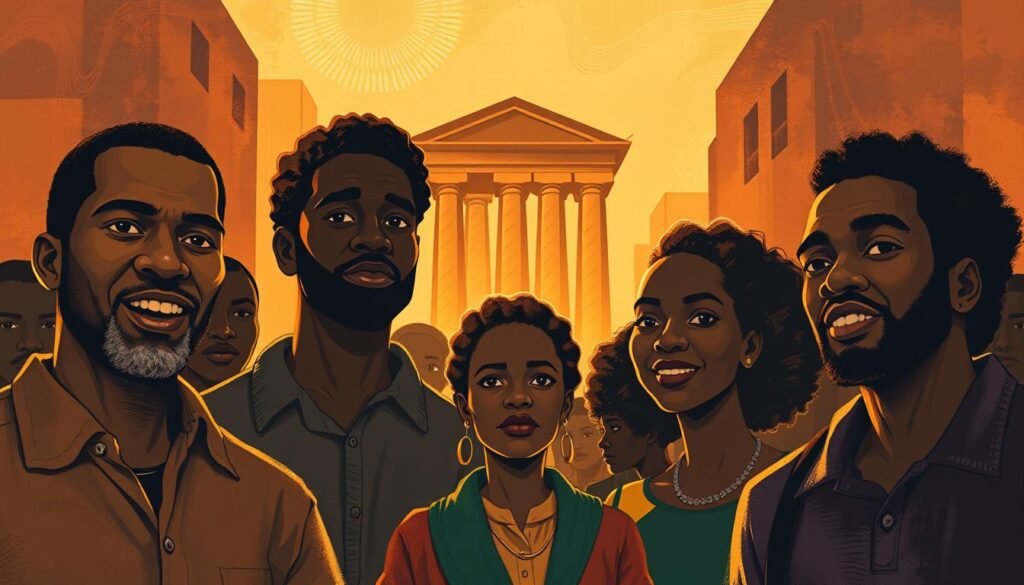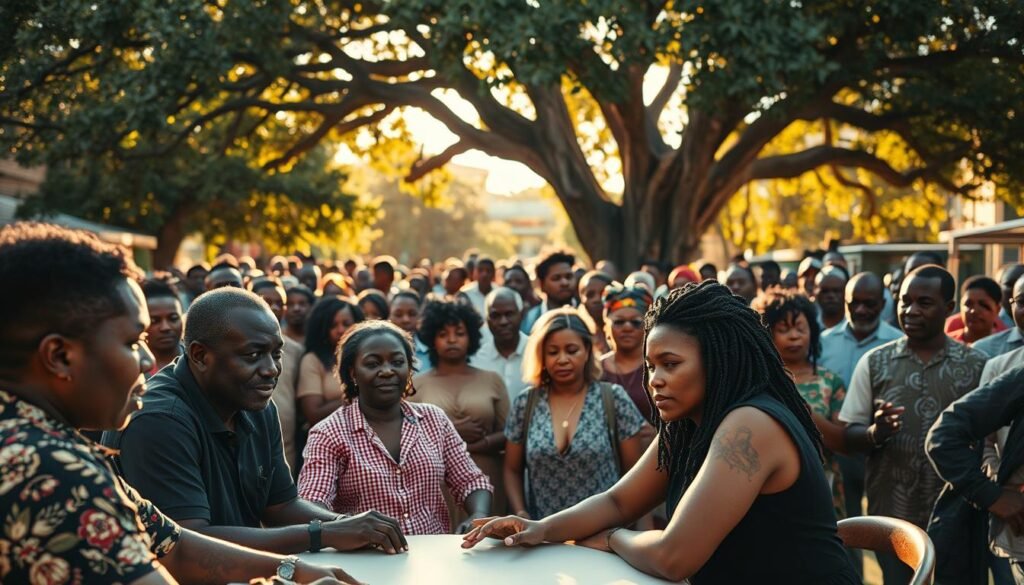One striking fact: money in Greenwood reportedly circulated inside the neighborhood for 19 months before leaving, showing exceptional local market power.
This story frames Greenwood as a data-rich case study in community-led success. The district hosted over 100 businesses, from banks and law firms to medical practices and grocery stores. Strong schools and high literacy helped sustain growth.
The account is not nostalgia. It is an evidence-driven review of ownership, finance access, education pipelines, and collaboration networks. It also traces how violence, insurance denials, and zoning barriers erased wealth and reshaped recovery.
Readers can follow a clear method that blends historical facts with practical playbooks for modern policy and business use. For deeper background, see this concise analysis on Greenwood’s documented strategies.
Key Takeaways
- Greenwood proved concentrated local ownership can compound community value.
- Financial institutions and schools were central to long-term resilience.
- Systemic sabotage—insurance denial and zoning—can erase generational wealth.
- Rebuilding relied on people, institutions, and coordinated business networks.
- Historical lessons offer actionable models for modern community wealth plans.
Black Wall Street Economic Lessons: Search Intent, Scope, And Why It Matters Today
Greenwood’s rise offers a measurable model for studying how local markets build wealth and face systemic threats.
Understanding Informational Intent For A Trend Analysis/Report
The report answers a clear informational need: readers want a trend analysis that links Greenwood’s business architecture to modern policy and practice.
Researchers from the University of Denver reframed Greenwood within patterns of racialized violence and media distortion. They introduced a racial violence triangle — pressure, opportunity, rationalization — to explain how success sometimes triggered attacks.
Applying Historical Insights To Present-Day U.S. Communities
The scope synthesizes firm density, money circulation, asset ownership, and education outcomes with qualitative drivers like narrative power and identity.
Findings translate into actionable opportunities for entrepreneurs and civic leaders through capital models (CDFIs, cooperatives), stronger education pipelines, and ecosystem collaboration.
“Black newspapers acted as corrective agents, documenting facts and defending community credibility.”
- Evaluation Criteria: equitable opportunity, reduced leakage of local spending, and stronger entrepreneur pipelines.
- Safeguards: insurance readiness, zoning awareness, and legal protections paired with business and education strategies.
| Indicator | Metric | Historic Greenwood | Modern Application |
|---|---|---|---|
| Firm Density | Businesses per block | 100+ firms; high local ownership | Support local incubators and CDFIs |
| Money Circulation | Months local | ~19 months | Buy-local campaigns; cooperative networks |
| Education Pipeline | Literacy & skills | Strong schools; high literacy | Align K–12 to entrepreneurship programs |
| Risk Safeguards | Policy & legal | Insurance denial; zoning threats | Preemptive legal frameworks; insurance access |
Greenwood District Tulsa: Data-Backed Baseline Of Prosperity And Shock
Quantitative records show Greenwood combined over 100 locally owned enterprises with banks, law offices, medical practices, grocers, and a chartered bus line. Strong schools and high literacy underpinned labor skills and civic institutions.
Economic Ecosystem: Banks, Professionals, Companies, And Schools
The district functioned as an integrated market. Banks provided credit, lawyers preserved titles, and businesses supplied each other. Owners reinvested in housing, health, and education, raising prosperity for residents.

Money Circulation And Market Independence In The Greenwood District
Researchers calculated money stayed inside the neighborhood for about 19 months before leaving. That metric indicates tight supplier linkages, deliberate patronage, and low leakage of spending to the wider city.
The Tulsa Race Massacre: Destruction, Insurance Denials, And Zoning Sabotage
On May 31–June 1, 1921, a white mob, aided by some officials, burned 35 blocks. Estimates cite roughly 300 people killed, more than 1,000 homes and businesses destroyed, and over 10,000 displaced.
Many claims were denied under “riot” clauses, and the city used zoning rules to block rebuilding. Fires wiped out ledgers and contracts, erasing evidence of accounts receivable and land claims.
Economic Outcomes: Lost Wealth, Displacement, And Partial Rebuilding
The shock collapsed firm density, created housing scarcity, and forced migration. Legal advocates such as B. C. Franklin fought from makeshift offices to reclaim rights and enable partial rebuilding.
Takeaway: the greenwood district tulsa case links concentrated prosperity with targeted policy and market harms, offering a baseline for measuring both drivers of wealth and systemic risk. For modern parallels and recovery work see modern Black Wall initiatives.
Core Principles From Black Wall: Self-Reliance, Education, Collaboration, And Ownership
Historical practice in Greenwood highlights practical tools communities can adapt to retain capital and build durable local markets. The core principles translate into modern instruments that leaders and residents can deploy to support firm formation, ownership, and long-term prosperity.
Self-Reliance And Community Finance
CDFIs, worker cooperatives, and Buy Black campaigns strengthen capital formation and procurement alignment. Community development financial institutions and mission lenders help banks finance microenterprises and property acquisition.
Education And Skill-Building
Targeted education pipelines convert skills into business creation. Programs like Operation HOPE, the Urban League Financial Empowerment Centers, UNCF, Thurgood Marshall College Fund, and Junior Achievement advance financial literacy and entrepreneurship for black entrepreneurs and entrepreneurs alike.
Collaboration And Asset Ownership
Networks such as the National Black Chamber of Commerce and Black Women’s Business Collective broker capital and mentorship for companies and growing businesses.
- Expand access to NACA mortgages, SBA lending, and MBDA services to increase ownership and generational wealth.
- Pair shared equity, community land trusts, and clear title systems to prevent displacement and protect asset appreciation.

For tactical steps on how to support emerging entrepreneurs, see support black entrepreneurs today.
Cultural Pride And Narrative Power: Media, Identity, And Economic Resilience
Local festivals, public art, and museums shape identity while generating real revenue for small business. These activities anchor history to place and invite shoppers, visitors, and new investment. Culture becomes a practical engine for prosperity when paired with clear branding.

Heritage As Economic Driver: Festivals, Branding, And Institutions
Events such as the Tulsa Juneteenth Festival and the Greenwood Art Project convert heritage into seasonal sales and vendor opportunities.
Institutions like the National Museum of African American History and Culture deepen education and turn exhibits into visits that boost nearby companies.
Countering Harmful Narratives: Black Newspapers And Community Voice
Since 1827, Black newspapers have investigated and corrected distorted accounts, protecting credibility and helping capital campaigns gain traction.
- Heritage branding builds trust and loyalty among people and communities, creating durable market differentiation.
- Positive storytelling supports ownership and place-based investment, improving access to funds.
- Partnerships between cultural institutions and entrepreneurs expand audiences and multiply local spending.
“Consistent, community-led storytelling is an economic strategy, not just a communications tactic.”
For guidance on cultural strategy and capacity building, see the culture report and research on building black-owned businesses. Together, culture and commerce create measurable gains in visitation, sales, and long-term prosperity.
Risk, Resilience, And Policy: From Disaster Planning To Equitable Opportunity
Preparedness and policy turn past shocks into practical safeguards for the future. Communities that pair risk assessment with inclusion strategies protect residents and local ownership when crises strike.
The Racial Violence Triangle: Pressure, Opportunity, And Rationalization
The University of Denver adapted the fraud triangle into a racial violence triangle to explain how economic gains can trigger targeted attacks. Pressure may come from resentment or competition. Opportunity appears when systems fail to protect land or records. Rationalization is the narrative that justifies harm.

Practical preparedness includes comprehensive disaster plans, insurance without riot exclusions, and off-site documentation backups. Time-sensitive steps protect claims: immediate accounting snapshots, title preservation, and vendor contract safekeeping.
“Risk management is not separate from growth; it is central to sustaining success across cycles.”
- Formalize risk reviews using the triangle to anticipate threats to business and land.
- Enable rapid relief with SBA Disaster Assistance Loans, emergency reserves, and community-managed funds.
- Push equitable city policy — zoning, anti-displacement measures, and fair permitting — to protect heritage corridors and local ownership.
- Strengthen social infrastructure: mutual aid, neighborhood associations, and education on legal rights, insurance, and media engagement.
These steps align resilience with inclusion so cities and communities build an economy that endures. For policy context and reparative frameworks, see this report on the Tulsa Race Massacre and recovery.
Final Thoughts
When residents control capital, education, and land, a community can build durable economic power. The Greenwood district combined self-reliance, collaboration, and cultural pride to create measurable prosperity and dense business activity.
That model shows success rests on more than commerce. It needs protective policy, legal readiness, and narrative strategies that reduce risk and speed recovery over time.
Practical next steps include fair lending, procurement access, inclusive zoning, and city–district partnerships that preserve land and cultural assets. Entrepreneurs and black entrepreneurs should use networks, CDFIs, and co‑ops to scale while keeping money circulating locally.
As a lasting reference in american history, district tulsa and the greenwood district remind planners that people‑centered measures—jobs, safety, and housing—are the ultimate test of wall street‑style performance at place level. For deeper historical context see the devastation of Black Wall Street and the birth of Greenwood’s hub.
